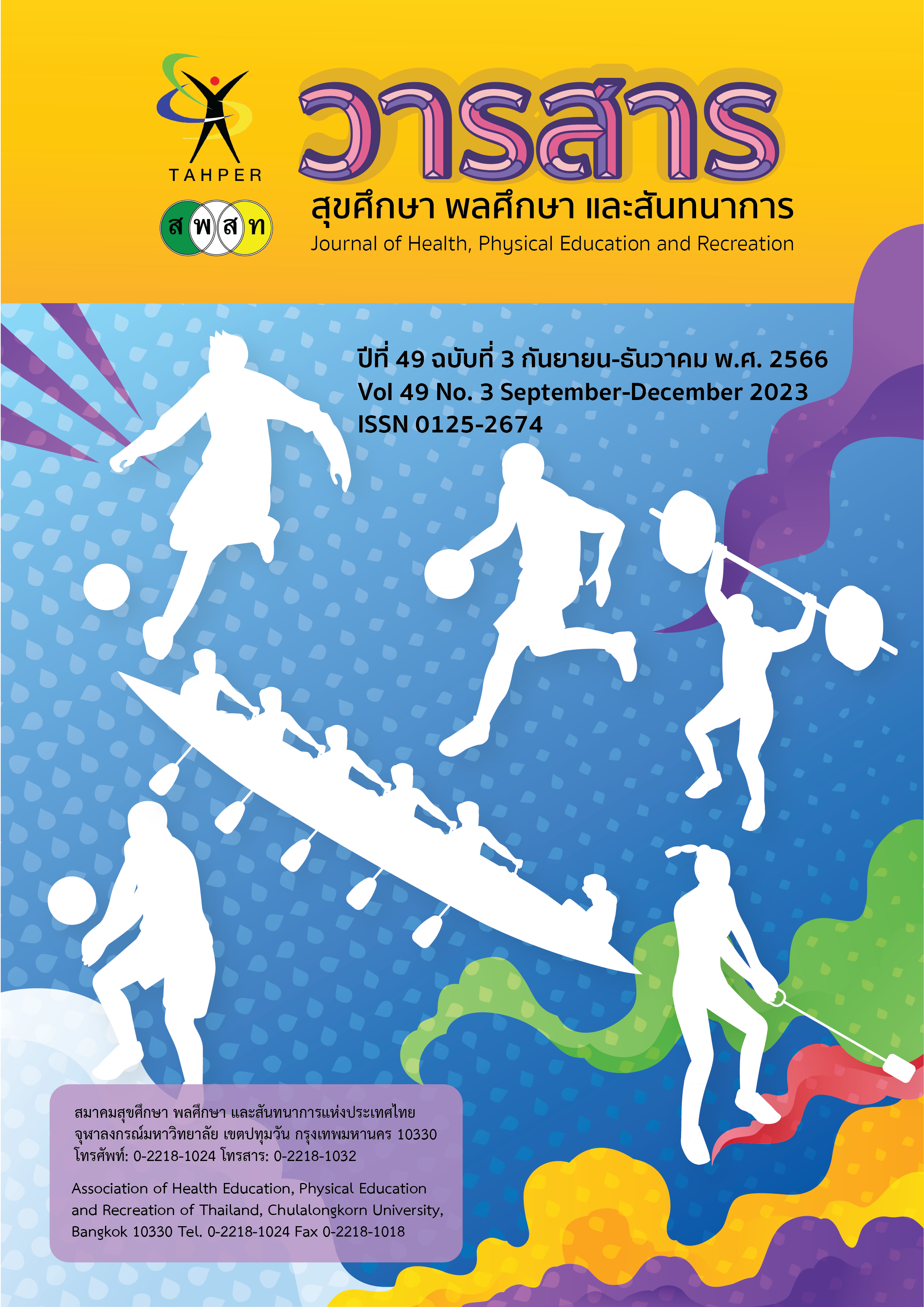Effects of Progressive Plyometric Training on Muscle Mass, Agility, and Futsal Dribbling Ability of Students at Phetchabun Rajabhat University
Main Article Content
Abstract
The purpose of this research was to study and compare the effects of progressive plyometric training on
muscle mass, agility, and futsal dribbling ability of students at Phetchabun Rajabhat University. The sample consisted of 30 students, males aged between 18-23 years, by purposive sampling. The samples were divided into 2 groups of 15 students each by a random matching method. The experimental group trained in progressive plyometric training, and the control group was not trained. The duration of the experiment was 4 weeks, 3 days each. The instrument used in this study was a progressive plyometric training program. Analyze the data by average, standard deviation, and compare the difference before and after the experimental group, by statistics Paired sample t-tests, and compare the difference between the experimental group and the control group, by statistics Independent sample t-test, the statistical significance level is set up at p ≤ .05.
The results showed that comparing the differences in muscle mass, agility, and futsal dribbling ability
before and after the experimental group. There were no differences in muscle mass (t = -1.33, p = 0.10).
However, the agility (t = 9.42, p = 0.00) and dribbling ability of futsal (t = 7.62, p = 0.00) was significantly
different at p ≤ .05, and compare the difference between the experimental group and the control group, muscle mass (t = -0.44, p = 0.33) were not different. However, the agility (t = -3.21, p = 0.00) and futsal dribbling ability
(t = -5.54, p = 0.00) was significantly different at p ≤ .05.
The research results have shown that 4 weeks of progressive plyometric training is effective in improving agility and futsal dribbling ability, but does not affect the muscle mass of students at Phetchabun Rajabhat University.
Article Details

This work is licensed under a Creative Commons Attribution-NonCommercial-NoDerivatives 4.0 International License.
Critical thinking in journals is the right of the author. The Association of Health Education, Physical Education and Recreation of Thailand is not always required, to create diversity in ideas and creativity.
ความคิด ข้อวิพากษ์ในวารสารเป้นสิทธิของผู้เขียน สมาคมสุขศึกษา พลศึกษา และสันทนาการแห่งประเทศไทยไม่จำเป็นต้องเห็นชอบด้วยเสมอไป เพื่อให้เกิดความหลากหลายในความคิดและความสร้างสรรค์
References
กรมพลศึกษา กระทรวงการท่องเที่ยวและกีฬา. (2555). คู่มือผู้ฝึกสอนกีฬาฟุตซอล T-Certificate : Futsal Coaching Guide. กรุงเทพฯ: สำนักงานกิจการโรงพิมพ์ องค์การสงเคราะห์ทหารผ่านศึกในพระบรมราชูปถัมภ์.
กรมพลศึกษา กระทรวงการท่องเที่ยวและกีฬา. (2558). ลักษณะของสัดส่วนร่างกาย องค์ประกอบของร่างกาย และสมรรถภาพทางกลไกของนักกีฬาฟุตซอลระดับเยาวชนไทย. กรุงเทพฯ: โรงพิมพ์วีรวรรณ พริ้นติ้งค์ แอนด์ แพ็คเก็จจิ้ง.
จักรกฤษณ์ พิเดช, อัจฉรียา กสิยะพัท และ ขจร ตรีโสภณากร. (2563). ผลของการฝึกพลัยโอเมตริกที่มีต่อความแข็งแรงและพลังของกล้ามเนื้อส่วนบนในนักกีฬาวอลเลย์บอลชาย. วารสารสุขศึกษา พลศึกษา และสันทนาการ, 46(2). 35-45.
จิตติ พลไพรินทร์ และ สมเกียรติ เนตรประเสริฐ. (2558). ผลของการฝึกความคล่องตัวที่มีต่อความสามารถในการเลี้ยงลูกฟุตบอลของนักกีฬาาฟุตบอลระดับมัธยมศึกษาตอนต้น ช่วงอายุ 12-15 ปี. วารสารวิชาการเครือข่ายบัณฑิตศึกษามหาวิทยาลัยราชภัฏภาคเหนือ, 5(8). 85-94.
ธนาคาร เสถียรพูนสุข, วัชรากร หวังหุ้นกลาง, พรทิพย์ แก้วชิณ, ธนพล หมื่นกูด, ณรงฤทธิ์ กล้าหาญ, ชัยมงคล เชื้อหมอดู. (2563). ผลของการฝึกพลัยโอเมตริกที่มีผลต่อความคล่องแคล่วว่องไวในนักกีฬาฟุตบอลวิทยาลัยนครราชสีมา. การประชุมวิชาการระดับชาติ วิทยาลัยนครราชสีมา ครั้งที่ 7 วันที่ 23 พฤษภาคม 2563 วิทยาลัยนครราชสีมา. นครราชสีมา. หน้า 1149-1154.
ธนาคาร เสถียรพูนสุข และ สมพร ส่งตระกูล. (2563). ศึกษาผลการฝึกพลัยโอเมตริกแบบวงจรด้วยยางรถ ที่มีต่อความเร็วและความคล่องแคล่วในนักกีฬาฟุตบอลโรงเรียน. วารสารสุขศึกษา พลศึกษา และสันทนาการ, 46(1), 82-91.
นภารินทร์ชัยงาม. (2552). ผลของโปรแกรมการฝึกพลัยโอเมตริกที่มีต่อความคล่องแคล่วว่องไวในนักกีฬาฟุตบอล. วิทยานิพนธ์ปริญญาโท, มหาวิทยาลัยเกษตรศาสตร์.
พิเชฐ สยมภูวนาถ. (2550). ผลของโปรแกรมฝึกพลัยโอเมตริกของกล้ามเนื้อขาที่มีผลต่อความเร็วในการเลี้ยง ลูกบอลของนักกีฬาฟุตบอล. วิทยานิพนธ์ปริญญาวิทยาศาสตรมหาบัณฑิต สาขาวิชาวิทยาศาสตร์การกีฬา, มหาวิทยาลัยเชียงใหม่.
วิศรุต ศรีแก้ว, ถวิชัยย์ ขาวถิ่น, วิมลมาศ ประชากุล. (2557). ผลของรูปแบบการฝึกพลัยโอเมตริกระยะเวลา
สัปดาห์ ที่มีต่อพลังกล้ามเนื้อและความคล่องแคล่วว่องไวในนักกีฬาฟุตบอล. วารสารวิทยาศาสตร์และ
เทคโนโลยีการกีฬา, 14(1). 11-24.
วรเชษฐ์ จันติยะ, ประทุม ม่วงมี และ เสกสรรค์ ทองคำบรรจง. (2563). ผลของการฝึกระหว่างพลัยโอเมตริกแนวพื้นลาดเอียงแนวพื้นราบ และแบบผสมผสานที่มีต่อ ตัวแปรเชิงแอนแอโรบิกการเร่งความเร็วและความสามารถในการกระโดด. วารสารสุขศึกษา พลศึกษา และสันทนาการ, 46(2). 235-250.
ศุภกร โกมาสถิตย์. (2552). ผลของการฝึกเสริมพลัยโอเมตริกที่มีต่อความสามารถในการเลี้ยงลูกฟุตซอลของนักกีฬาฟุตซอล ระดับมัธยมศึกษาตอนปลาย. วิทยานิพนธ์การศึกษามหาบัณฑิต สาขาวิชาพลศึกษา คณะครุศาสตร์, จุฬาลงกรณ์มหาวิทยาลัย.
สนธยา สีละมาด. (2560). หลักการฝึกกีฬาสำหรับผู้ฝึกสอนกีฬา (พิมพ์ครั้งที่ 5). กรุงเทพฯ: สำนักพิมพ์แห่งจุฬาลงกรณ์มหาวิทยาลัย.
สหรัฐฯ ศรีพุทธา. (2560). ผลของการฝึกเสริมพลัยโอเมตริกควบคู่กับการฝึกกล้ามเนื้อแกนกลางลำตัวที่มีต่อความ คล่องแคล่วว่องไวในนักกีฬาฟุตซอล. วิทยานิพนธ์ปริญญาวิทยาศาสตรมหาบัณฑิต สาขาวิชาวิทยาศาสตร์การกีฬา คณะวิทยาศาสตร์การกีฬา, จุฬาลงกรณ์มหาวิทยาลัย.
สำนักวิทยาศาสตร์การกีฬา กรมพลศึกษา กระทรวงการท่องเที่ยวและกีฬา. (2560). การทดสอบสมรรถภาพทางกายภาคสนาม กีฬาฟุตบอล-ฟุตซอล วอลเลย์บอล แบดมินตัน. กรุงเทพฯ: บริษัท ซัน แพคเกจจิ้ง (2014) จำกัด.
หริต หัตถา, บรรจบ ภิรมย์คำ, วัลลีย์ ภัทโรภาส. (2557). ผลของการฝึกพลัยโอเมตริกที่มีต่อความคล่องแคล่วว่องไวของนักกีฬาฟุตซอล. วารสารวิทยาศาสตร์และเทคโนโลยีการกีฬา, 14(2). 53-63.
อุมาริน หิรัญอร และ สังเวียน ปินะกาลัง. (2558). ผลของโปรแกรมการฝึกความคล่องแคล่วว่องไวที่มีต่อความสามารถในการเลี้ยงลูกฟุตซอลชั้นมัธยมศึกษาตอนต้น. วารสารศึกษาศาสตร์ ฉบับวิจัยบัณฑิตศึกษา มหาวิทยาลัยขอนแก่น, 9(4). 228-236.
อำนาจ ธูปบูชา และ สมเกียรติ เนตรประเสริฐ. (2558). ผลการฝึกเสริมด้วยโปรแกรมการฝึกความคล่องแคล่วว่องไวที่มีต่อความสามารถในการเลี้ยงลูกฟุตบอลของนักกีฬาฟุตบอลชาย อายุ 16-18 ปี. วารสารวิชาการเครือข่ายบัณฑิตศึกษามหาวิทยาลัยราชภัฏภาคเหนือ, 5(8). 131-142.
Bompa, T. O. (1993). Periodization of strength: the new wave in strength training. Toronto: Veritas Publishing.
Cohen, J. (1988). Statistical power analysis for behavioral sciences. (2nd ed). Hillsale, NJ: Lawrence Erlbaum.
Craig, B.W. (2004). What is the scientific basis of speed and agility?. Strength and Conditioning, 26(3). 13-14.
Getchell, B. (1979). Physical Fitness: A Way of Life. (2nd ed.). New York: John Wiley and Sons.
Jozo Grgic, Brad J Schoenfeld, Pavle Mikulic. (2020). Effects of plyometric vs. resistance training on skeletal muscle hypertrophy: A review. Journal of Sport and Health Science, 10(5). 530-536.
Miller, J.M., S.C. Hilbert and L.E. Brown. (2001). Speed, quickness, and agility training for senior tennis players. Strength and Conditioning, 23(5). 62-66.
N Makaje, R Ruangthai, A Arkarapanthu, P Yoopat. (2012). Physiological demands and activity profiles during futsal match play according to competitive level. The journal of sports medicine and physical fitness, 52(4). 366-374.
Rodrigo Ramírez-Campillo, Marcelo Vergara-Pedreros, Carlos Henríquez-Olguín, Cristian Martínez-Salazar, Cristian Alvarez, Fábio Yuzo Nakamura, Carlos I. De La Fuente, Alexis Caniuqueo, Alicia M. Alonso-Martinez and Mikel Izquierdo. (2016). Effects of plyometric training on maximal-intensity exercise and endurance in male and female soccer players. Journal of sports sciences, 34(8). 687-693.
Somruthai Poomsalood and Sasima Pakulanon. (2015). Effects of 4-week Plyometric Training on Speed, Agility, and Leg Muscle Power in Male University Basketball Players: A Pilot Study. The Kasetsart Journal of Social Sciences, 36(3). 598-606.
Twist, P.W. and D. Benickly. (1996). Conditioning lateral movements for multi-sport athletes: Practical strength and quickness drills. Strength and Conditioning, 18(5). 10-19.
Young M.H.B. McDowell and B.J. Scarlett. (2001). Specificity of sprint and agility training methods. Journal of Strength and Conditioning Research, 15(3). 315-319.
Young and Farrow. (2006). A Review of Agility: Practical Applications for Strength and Conditioning. National Strength and Conditioning Association, 28(5). 24-29.


